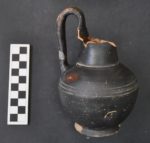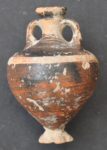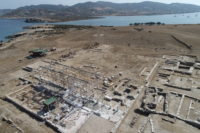 The uninhabited Cycladean islet of Despotiko is tiny in dimension but immense in archaeological importance thanks to the sanctuary of Apollo built there in the 6th century B.C. during the Greek Archaic period. The sanctuary was heavily damaged in the 5th century by Athens in retaliation for Paros’ support of Xerxes during the second Persian invasion of Greece, but excavations have found archaeological evidence of extended rebuilding through the late Hellenistic period (2nd century B.C.).
The uninhabited Cycladean islet of Despotiko is tiny in dimension but immense in archaeological importance thanks to the sanctuary of Apollo built there in the 6th century B.C. during the Greek Archaic period. The sanctuary was heavily damaged in the 5th century by Athens in retaliation for Paros’ support of Xerxes during the second Persian invasion of Greece, but excavations have found archaeological evidence of extended rebuilding through the late Hellenistic period (2nd century B.C.).
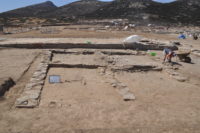 Located almost exactly at the center of the Cyclades, Despotiko has sightline views of eight of the islands and was connected to Antiparos and Koimitiri by an isthmus when the temple was built. The thorough excavation of Despotiko began in 1997 and has continued ever since, systematically bringing to light a temple complex much larger, longer-lived and more significant than archaeologists had realized.
Located almost exactly at the center of the Cyclades, Despotiko has sightline views of eight of the islands and was connected to Antiparos and Koimitiri by an isthmus when the temple was built. The thorough excavation of Despotiko began in 1997 and has continued ever since, systematically bringing to light a temple complex much larger, longer-lived and more significant than archaeologists had realized.
This season’s excavation has unearthed the remains of three more structures raises the tally of buildings in the complex to 22. Archaeologists now believe that the Despotiko temple may have been the largest in the Cyclades, eclipsing in size the much more famous Sanctuary of Apollo on the island of Delos, mythical birthplace of Apollo and Artemis.
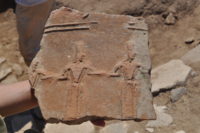 The dig explored areas surrounding the archaic sanctuary, focusing on a site just south of the main temple and two buildings labelled Z and P. One of the three structures discovered is a rectangular two-story building 26 x 10.5 feet found underneath the westernmost rooms of the temple complex. It was built in the 6th century B.C. and intriguingly still contained a grid and cooking pot in their original location. Archaeologists also found original floors and sealed off entrances.
The dig explored areas surrounding the archaic sanctuary, focusing on a site just south of the main temple and two buildings labelled Z and P. One of the three structures discovered is a rectangular two-story building 26 x 10.5 feet found underneath the westernmost rooms of the temple complex. It was built in the 6th century B.C. and intriguingly still contained a grid and cooking pot in their original location. Archaeologists also found original floors and sealed off entrances.
Another structure, dubbed Building T, is just barely a rectangle at 25.6 feet x 24.4 feet. There are two rooms, each with their own entry and their own front yards. (Is it weird that my first thought was “nice setup for an Airbnb”?) The last of the newly-unearthed structures, Building Y, is 25 x 20 feet. Its design is reminiscent of a church nave with an entrance on the south side and walls three feet thick.
 In addition to the architectural remains, the dig also discovered a wealth of artifacts, almost all of which are estimated to date to the 6th century B.C.
In addition to the architectural remains, the dig also discovered a wealth of artifacts, almost all of which are estimated to date to the 6th century B.C.
Like every year, this year’s findings were rich. More than 15 lamps and 15 fragments of vases with engraved inscriptions (APL, APOL) were found, fragments of amphorae and red-colored craters, everyday vases such as basins, bowls, pans, bottles, and many metallic objects (a bronze lance, nails, russets, hooks, etc.).
From this year’s discoveries what stood out were the fragment of the head of an archaic kouros, a fragment from the ankle of a kouros and scraps of two piths with embossed decoration, one depicting a warrior and the other a dance show.
 While the excavation shed new light on the early history of the Despotiko sanctuary, restorers set to shoring up the masonry of two previously unearthed buildings and on raising a part of the main temple of Apollo up from the ground. After four weeks of work, columns, lintels and walls are vertical, recreating some small portion of the sanctuary’s height and making it once again visible from Antiparos.
While the excavation shed new light on the early history of the Despotiko sanctuary, restorers set to shoring up the masonry of two previously unearthed buildings and on raising a part of the main temple of Apollo up from the ground. After four weeks of work, columns, lintels and walls are vertical, recreating some small portion of the sanctuary’s height and making it once again visible from Antiparos.
